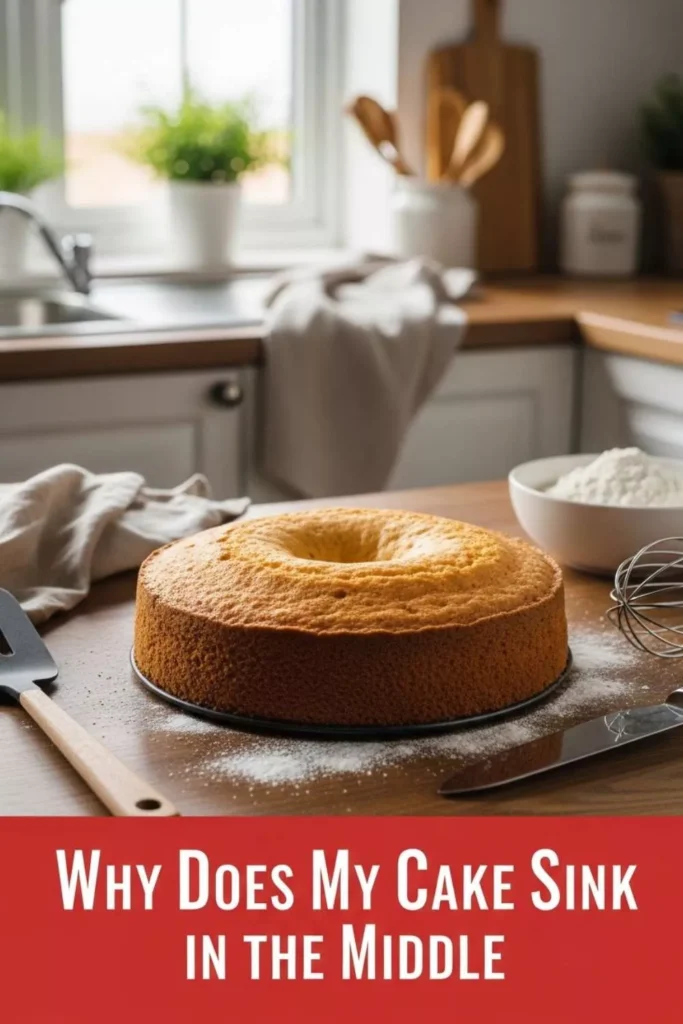There’s nothing more disappointing than pulling a beautiful cake out of the oven—only to watch it collapse in the center as it cools. If your cake keeps sinking in the middle, don’t worry—you’re not alone!
Even experienced bakers face this issue. The good news is, once you understand why it happens, you can easily prevent it next time.
Let’s break down the most common reasons your cake sinks in the middle—and how to fix them step-by-step.

1. Underbaking (The Most Common Culprit)
If the center of your cake isn’t fully baked when you take it out of the oven, it will collapse as it cools. The outer edges might look done, but the inside could still be raw or too moist.
How to Fix It:
- Always test your cake with a toothpick or skewer in the center. It should come out clean or with a few crumbs, not wet batter.
- If your cake top is browning too fast but the middle is still raw, cover it loosely with foil and continue baking.
- Use an oven thermometer to ensure your oven is reaching the correct temperature.
2. Opening the Oven Door Too Early
Peeking into the oven too soon can cause your cake to sink! The sudden rush of cool air can interrupt the rising process, especially before the structure has set.
How to Fix It:
- Avoid opening the oven during the first 20–25 minutes of baking.
- Only check your cake toward the end of the baking time.
3. Incorrect Oven Temperature
An oven that’s too hot or too cool can throw off your cake’s structure.
- Too hot: The cake rises quickly, then collapses because the center can’t support the height.
- Too cool: The cake won’t rise enough and will stay dense or sunken.
How to Fix It:
- Use an oven thermometer (many ovens are off by 10–25°F).
- Preheat your oven fully before baking.
- Follow the recipe temperature exactly—don’t adjust unless you’ve tested it.
4. Overmixing the Batter
Overmixing adds too much air and develops too much gluten, which can make the cake rise too quickly and then deflate as it cools.
How to Fix It:
- Mix until ingredients are just combined.
- When adding flour, use low speed or fold by hand.
- Avoid beating the batter after adding the dry ingredients.
5. Too Much Leavening Agent (Baking Powder or Baking Soda)
It’s tempting to think that more baking powder or soda = fluffier cake. But too much can cause the cake to rise rapidly and then collapse.
How to Fix It:
- Measure carefully—level your teaspoons and tablespoons.
- Use fresh leavening agents (check the expiration date!).
- Follow the recipe exactly; don’t “eyeball” it.
6. Wrong Pan Size
If your cake batter is too deep in a small pan, the outside will cook faster than the inside, leaving the center underbaked and prone to sinking.
How to Fix It:
- Always use the recommended pan size in the recipe.
- If you change pan sizes, adjust the baking time accordingly.
- For deeper cakes, lower the oven temperature by 25°F and bake longer.
7. Too Much Moisture or Heavy Ingredients
Adding too much liquid, fruit, or other moist ingredients (like applesauce or yogurt) can throw off the batter’s structure and cause sinking.
How to Fix It:
- Stick to the exact ingredient measurements in the recipe.
- Drain excess liquid from fruits or veggies before adding.
- Avoid substituting ingredients unless you know how they affect texture.
8. Cooling Too Quickly
Sudden temperature changes can cause a cake to shrink or collapse in the center.
How to Fix It:
- Let the cake cool in the pan for 10–15 minutes before removing it.
- Avoid placing a hot cake near a fan, air conditioner, or open window.
Bonus Tip: Altitude & Humidity Matter
If you live in a high-altitude or very humid area, your cakes may behave differently.
- At high altitudes, reduce baking powder slightly and increase baking temperature by 15–25°F.
- In humid climates, store dry ingredients in airtight containers and bake a few minutes longer.
How to Fix a Cake That Already Sank
If your cake has already sunk—don’t toss it out! Here are a few ways to save it:
- Fill it: Add frosting, whipped cream, or fruit to cover the dip.
- Flip it: Turn it into a trifle by layering it with cream and berries.
- Trim it: Cut the top flat and frost it evenly for a smooth finish.
Final Thoughts
A sunken cake can feel like a disaster, but it’s actually one of the easiest baking problems to solve. Most of the time, it’s a simple fix—like checking your oven temperature or mixing less.
With a few adjustments, you’ll be pulling out perfectly fluffy, evenly baked cakes every time.
So the next time you ask, “Why did my cake sink in the middle?”—you’ll know exactly what to do.